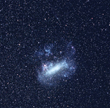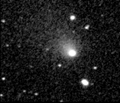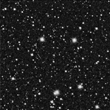
Without a doubt, the most famous comet of the 1990's was comet Hale-Bopp. It has been one of the largest and brightest comets on record. It was observed with the naked eye for longer than any other comet and it has been followed by amateurs longer than any other comet.
Comet Hale-Bopp was discovered in July,1995, as a small, faint object close to M22 in Sagittarius. My first opportunity to observe the comet came on August 30, 1995, when the comet was passing close to the globular cluster, NGC 6624. At that time the comet was about magnitude 10.6.

Two months later, shortly before conjunction with the sun, the comet had brightened slightly and was visible in an 8" telescope. A short, fan-shaped tail was also becoming faintly visible.

Following conjunction, the comet was eagerly sought to see how fast it was brightening. However it was somewhat overshadowed by the spectacular display put on by Comet Hyakutake.
By April 1996, comet Hyakutake was lost to southern hemisphere observers and so more attention was given to comet Hale-Bopp. By this time, the comet was visible in binoculars, and with a telescope, displayed a short, faint, and very curved tail.

The comet continued to brighten steadily, finally reaching naked eye visibility in May,1996. By September, the tail was quite prominent to the naked eye.

By October, the comet was an easy naked-eye object in Ophiuchius drifting past the Globular cluster M14 in the western sky as it headed towards conjunction once again.

Following this conjunction, the comet was to be at its brightest, and promised to be a very impressive sight. Unfortunately for southern observers, the comet was confined to the northern skies during this time. By mid-November, 1996 the comet had been lost to southern observers.
Comet Hale-Bopp finally returned to southern skies in mid April of 1997, with my first sighting of it on April 23, when the comet was only a couple of degrees above the horizon, deep in the twilight. Even so it was a very bright object at about magnitude -1.0. During May the comet was a magnificent show even though it was always very low to the horizon in the evening twilight.
The first week of May gave southern hemisphere observers their best views of the comet. Knowing in advance that this would be the case, I organised a week-long astrocamp for the Murdoch Astronomical Society at Meeline Station, some 650km north-east of Perth. With the nearest town more than 60km away, the skies were unbelievably dark, resulting in wonderful views of the comet along with numerous other deep-sky objects.

By August the comet was still a naked eye object although the tail was much reduced. On August 29 comet Hale-Bopp drifted past the open cluster M93.

By October of 1997, the comet had drifted into the southern Milky Way, giving rise to several conjunctions with open clusters that made fine sights in binoculars or a wide-field telescope.


Comet Hale-Bopp continued to be visible to the naked eye until the beginning of 1998, making it visible to the naked eye for longer than any previous comet.
Before the comet faded below naked eye visibility it passed close to the Large Magellanic Cloud. From the dark skies of the Chiro Observatory, the conjunction made a fine sight, particularly in binoculars.

By January 1999 the comet was below magnitude 11 and once again becoming a difficult object for film imaging.

However when imaged with a CCD the comet still showed a good-sized coma and tail.

In early 2000, the comet continued to fade very slowly as it drifted amongst the far southern skies. As it faded, the coma shrank in size and the tail disappeared. By the end of April, the comet was around 13th magnitude. Very difficult visually, but an easy object for the CCD.

During May 2000 the comet passed through the outer fringes of the Large Magellanic Cloud. At this time it became very difficult to distinguish amongst the dense star fields.

In late in 2000, comet Hale-Bopp finally became too faint to be visible to the eye in a 12" telescope. However it continued to be an easy target for CCD's.

During 2001, the comet continued to fade steadily as it moved farther away from the Sun. By the end of March, the comet was over 13AU from the Sun, yet still showed some coma.

On June 20, 2001, a few weeks before I left Australia to take up employment in the USA, I made what I expected to be my final observation of the comet.

After 4 years away, I was able to go back to Australia and spend several weeks observing. One of the objects I decided to try for was comet Hale-Bopp. Although predicted to be almost 19th magnitude, I was interested to see if it was still reachable with the same telescope that I had used for my first observation 10 years previously. I was pleasently surprised to find that on each of the 4 nights when I attempted to image the comet, it was faintly recorded.

Comet Hale-Bopp was visible for over 10 years and was visible to the naked eye for longer than any other comet. It has also been visible further from the sun than any other comet. It truely has been a great comet!